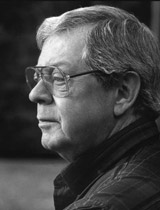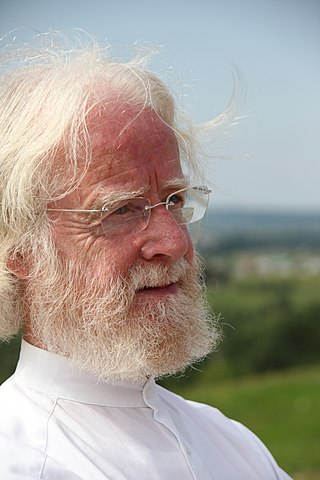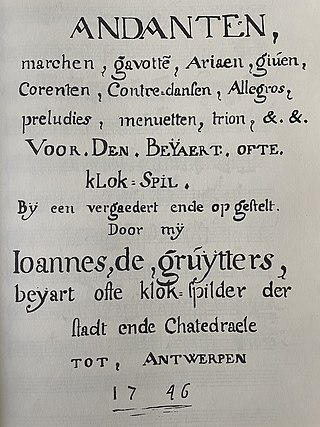
A carillon ( KERR-ə-lon, kə-RIL-yən) is a pitched percussion instrument that is played with a keyboard and consists of at least 23 bells. The bells are cast in bronze, hung in fixed suspension, and tuned in chromatic order so that they can be sounded harmoniously together. They are struck with clappers connected to a keyboard of wooden batons played with the hands and pedals played with the feet. Often housed in bell towers, carillons are usually owned by churches, universities, or municipalities. They can include an automatic system through which the time is announced and simple tunes are played throughout the day.

The Yale Memorial Carillon is a carillon of 54 bells in Harkness Tower at Yale University in New Haven, Connecticut.

Matthias Vanden Gheyn was a Flemish musician from the Baroque/Classical transition period. He is a descendant of the famous bell founding family of the same name. During his life, Vanden Gheyn was considered an outstanding virtuoso of the carillon and organ. He is most famous for composing eleven preludes for carillon, which have become standard repertoire among carillonneurs worldwide since the early 1900s. His spot in history was earned in large part due to the tireless research of his biographer Xavier-Victor-Fidèle van Elewyck, a law and music scholar who considered Vanden Gheyn to be the greatest musician of the Southern Netherlands in the 18th century.

A chime or set of chimes is a carillon-like instrument, i.e. a pitched percussion instrument consisting of 22 or fewer bells. Chimes are primarily played with a keyboard, but can also be played with an Ellacombe apparatus. Chimes are often automated, in the past with mechanical drums connected to clocks and in the present with electronic action. Bellfounders often did not attempt to tune chime bells to the same precision as carillon bells. Chimes are defined as specifically having fewer than 23 bells to distinguish them from the carillon. American chimes usually have one to one and a half diatonic octaves. According to a recent count, there are over 1,300 existing chimes throughout the world. Almost all are in the Netherlands and the United States, with most of the remainder in Western European countries.

JonkheerJacob van Eyck was a Dutch nobleman, composer and blind musician. He was one of the best-known musicians of the Dutch Golden Age, working as a carillon player and technician, a recorder virtuoso, and a composer. He was an expert in bell casting and tuning, and taught Pieter and François Hemony how to tune a carillon. Van Eyck is credited with developing the modern carillon together with the brothers in 1644, when they cast the first tuned carillon in Zutphen. He is also known for his collection of 143 compositions for recorder, Der Fluyten Lust-hof, the largest work for a solo wind instrument in European history.

The Royal Carillon School "Jef Denyn" is a music school in Mechelen, Belgium, that specializes in the carillon. It is the first and largest carillon school in the world. The Belgian government defines it as an "International Higher Institute for the Carillon Arts under the High Protection of Her Majesty Queen Fabiola". The school has trained many of the foremost carillonneurs of the twentieth and twenty-first centuries and houses a rich archive and library.
The Anton Brees Carillon Library, located within the Singing Tower at Bok Tower Gardens, Lake Wales, Florida, is home to various collections that document the history and development of the Singing Tower and its gardens, the historic Pinewood Estate, and The Guild of Carillonneurs in North America. It also contains many sources on carillon art in general.
John Edward Courter was an American composer, organist, and carillonneur who served as a professor of music at Berea College in Berea, Kentucky, from 1971 until his death on June 21, 2010. A native of Lansing, Michigan, Courter earned a bachelor's degree in choral music education from Michigan State University in 1962 and a Master's of Music degree in organ in 1966 from the University of Michigan. He also studied at the North German Organ Academy and held diplomas from the Netherlands Carillon School.

William Gorham Rice Sr. was an American state and federal government official from Albany, New York, and civic activist engaged in the reform of the civil service system. He was a biographer of Grover Cleveland, and became an authority on carillons in America and Europe and authored three books on the topic.

Ronald Montague Barnes was an American carillonist, composer, and musicologist. He first began playing the carillon as a teenager at his hometown's church. In 1952, at 24 years old, he was appointed to play the carillon at the University of Kansas, where he developed as a musician. He was later the carillonist for the Washington National Cathedral from 1963 to 1975 and the University of California, Berkeley, from 1982 until his retirement in 1995. He was an involved member of The Guild of Carillonneurs in North America, having served as its president, vice president, and several other roles.

Jozef Willem Haazen is a Flemish musician and carillonneur.
Julianne Vanden Wyngaard is a professional carillonist and pianist residing in Grand Rapids, Michigan, who served as vice president of The Guild of Carillonneurs in North America (GCNA), as well as president from 2017-2019. In a predominantly male and white field, Vanden Wyngaard has distinguished herself through musical and professional accolades.
Ulla Laage is a Danish carillonneur and composer. She was the first carillonneur to hold a full-time carillon performance position in Denmark, and one of a small number of women to hold a professional carillon post in Europe during the twentieth century.
Sally Slade Warner was a leading American carillonneur, carillon composer and arranger, and a church organist. She played the carillon at St. Stephen's Episcopal Church in Cohasset, Massachusetts, and the former carillon at Phillips Academy in Andover, Massachusetts.

The De Gruytters carillon book is a manuscript notebook that the Dutch Baroque musician Joannes de Gruytters used for performance on the carillon of the city of Antwerp. It contains 194 pieces of music, mostly arrangements and a few original compositions, in the form of marches, gavottes, arias, gigues, preludes, and minuets, among others.
The Queen Fabiola Competition is an international music competition for carillon. It was established in 1987 by the Royal Carillon School "Jef Denyn" to supersede the smaller annual competitions held in Belgium. Named after Queen Fabiola of Belgium, the competition's original patron, it was modeled after the Queen Elizabeth Competition. Its establishment was supported by the Flemish Government, Antwerp Province, and the city of Mechelen.









